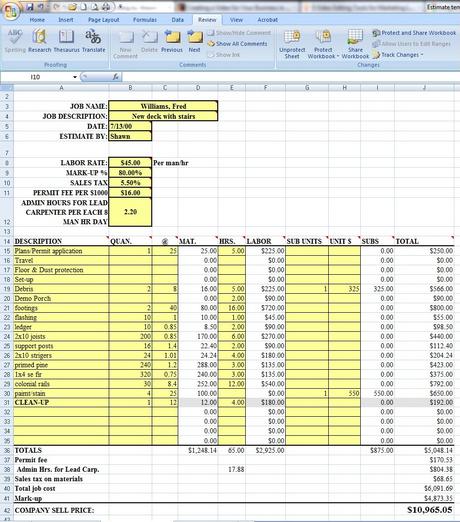Remodeling Prospects Need A New Process For Coming To A Buying Decision

Consumers need a new process for coming to a decision. This definitely includes consumers considering remodeling projects at their homes. They can no longer assume they will increase the value of their home just because they remodel. Even low price might not be a compelling reason to buy. They need new reasons to go forward, and it becomes the salesperson’s job to help them find those reasons.
Every consumer must go through due diligence before making a buying decision and this is further complicated because each one will have a different path; one that is personal to them. They are journeying into new areas and might not even know how or where to get started. The new remodeling salesman must be a decision engineer, methodically guiding consumers through their specific emotional and intellectual considerations relative to making a confident buying decision.
Notice I said guide them

They must feel like the decision and the process they went through was their own and that they didn’t miss anything that should have been considered. The old school approach of telling or convincing a prospect what to do will no longer work. Once they come to realize a process for making their decision, the salesman must then become a trusted adviser, with the knowledge and ability to offer appropriate design, product and project delivery options.
The consumer has come to expect options
 Manufacturers can and should provided information and education relative to product options, differences and price points. Retailers selling to remodelers should be getting this information from their distributor and manufacturer reps. The entire supply chain should be sharing this information with contractors through trade shows, educational events and personal interaction.
Manufacturers can and should provided information and education relative to product options, differences and price points. Retailers selling to remodelers should be getting this information from their distributor and manufacturer reps. The entire supply chain should be sharing this information with contractors through trade shows, educational events and personal interaction.
To improve sales and ultimately business results, I suggest remodelers find good retailers to do business with who will provide this information; then attend their offerings and study up.


 Guest Blogger: Spencer Powell, Inbound Marketing Director at TMR Direct. Spencer joined
Guest Blogger: Spencer Powell, Inbound Marketing Director at TMR Direct. Spencer joined 
 In addition to becoming a trusted advisor, the more content you create on your website, the more chances you have to actually get found in search engines like Google. Google LOVES content, so the more you create, the more you'll be found. Just think of your website like a planet. The more pages and articles you create, the bigger the planet gets, and the more gravitational pull it has. So, you'll be pulling in more web visitors.
In addition to becoming a trusted advisor, the more content you create on your website, the more chances you have to actually get found in search engines like Google. Google LOVES content, so the more you create, the more you'll be found. Just think of your website like a planet. The more pages and articles you create, the bigger the planet gets, and the more gravitational pull it has. So, you'll be pulling in more web visitors.  Now you're in great position to solidify your company as one of their options for helping them achieve their goal. This is where lead nurturing comes into play. Lead nurturing is simply sending out helpful emails with more information that helps your prospect do research. These emails allow you to stay in touch with the prospect all the way through the sales cycle. How to execute a lead nurturing campaign is the topic for another post, but are you starting to see how your website can really get you involved in the homeowner sales cycle?
Now you're in great position to solidify your company as one of their options for helping them achieve their goal. This is where lead nurturing comes into play. Lead nurturing is simply sending out helpful emails with more information that helps your prospect do research. These emails allow you to stay in touch with the prospect all the way through the sales cycle. How to execute a lead nurturing campaign is the topic for another post, but are you starting to see how your website can really get you involved in the homeowner sales cycle?
 They may be challenged if no longer the one in control of the design process, the construction methods and the client.
They may be challenged if no longer the one in control of the design process, the construction methods and the client. Will they refer you to their own clients?
Will they refer you to their own clients?
 Knowing what to charge clients for the work you do is often the difference between long term success and eventual failure for the business. Many contractors look at estimating simply as a way to determine the cost of a project. In the traditional design-bid model of project delivery, this simplistic approach may work, assuming your sell price generates enough gross profit to cover your overhead and profit requirements. However, if you’re doing design/build, and your current estimating system is limited to only producing the number you charge clients for a project, you may be missing out on many other possible benefits.
Knowing what to charge clients for the work you do is often the difference between long term success and eventual failure for the business. Many contractors look at estimating simply as a way to determine the cost of a project. In the traditional design-bid model of project delivery, this simplistic approach may work, assuming your sell price generates enough gross profit to cover your overhead and profit requirements. However, if you’re doing design/build, and your current estimating system is limited to only producing the number you charge clients for a project, you may be missing out on many other possible benefits. If you think of Design/Build as a way of doing business, your estimating system must become a tool that facilitates how you do business, not just a way to get to the price. Here are several ways a Design/Builder or a remodeler can maximize the potential of the method and system used to do estimating:
If you think of Design/Build as a way of doing business, your estimating system must become a tool that facilitates how you do business, not just a way to get to the price. Here are several ways a Design/Builder or a remodeler can maximize the potential of the method and system used to do estimating:
 A long time ago a remodeler in my NARI Chapter who was just starting his business asked me for advice about how he too could have a successful and profitable business. Seeking to keep my response simple and to the point I came up with a list of nine steps. When I was explaining my list to him he asked where he would find the time to do all these things. He said he was already straight out trying to sell and complete work. That’s when I added step number one to the ten step list below.
A long time ago a remodeler in my NARI Chapter who was just starting his business asked me for advice about how he too could have a successful and profitable business. Seeking to keep my response simple and to the point I came up with a list of nine steps. When I was explaining my list to him he asked where he would find the time to do all these things. He said he was already straight out trying to sell and complete work. That’s when I added step number one to the ten step list below.  Recharge Your Batteries!
Recharge Your Batteries!
 8 Smart Budget Curb Appeal Makeovers
8 Smart Budget Curb Appeal Makeovers 25 Manliest Homes in America
25 Manliest Homes in America Consider the
Consider the  In most cases, doing the design before you get a commitment from your clients for the build puts you into a bidding situation, something most Design/Builders seek to avoid. It’s also the reason many business owners give me for getting into true Design/Build to begin with; to get out of the “bidding game”. These businesses become “Design/Build Businesses”. They have chosen a niche to concentrate on and to build a brand around. Deviating from the process weakens or changes the brand.
In most cases, doing the design before you get a commitment from your clients for the build puts you into a bidding situation, something most Design/Builders seek to avoid. It’s also the reason many business owners give me for getting into true Design/Build to begin with; to get out of the “bidding game”. These businesses become “Design/Build Businesses”. They have chosen a niche to concentrate on and to build a brand around. Deviating from the process weakens or changes the brand. The process described above is not for every contractor and it’s not for every client. I am not suggesting using any other process is wrong; not at all. It’s still a free country and you can do business any way you want, as long as you operate legally. I am saying that if you separate the two processes don’t tell consumers that you are a “Design/Build Business”. Maybe yours is a remodeling business that offers both design/build and the traditional design/bid process. That is a good business model, too. Explain the difference and give your prospects the option to choose one or the other.
The process described above is not for every contractor and it’s not for every client. I am not suggesting using any other process is wrong; not at all. It’s still a free country and you can do business any way you want, as long as you operate legally. I am saying that if you separate the two processes don’t tell consumers that you are a “Design/Build Business”. Maybe yours is a remodeling business that offers both design/build and the traditional design/bid process. That is a good business model, too. Explain the difference and give your prospects the option to choose one or the other.





